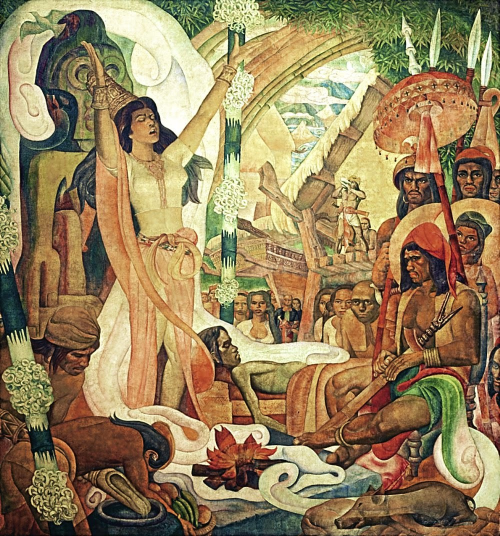
‘Babaylan, Ang Manggagamot.’ Detail of mural “History of Philippine Medicine” by Carlos “Botong” Francisco | Photo from XiaoChua.net
New York — This October 4th saw the start of the synod, an ecclesiastical and advisory council, called by Pope Francis to deliberate and contemplate on issues that may shape future Church policies and/or alter current ones on a number of issues.
The synod is made up of 365 voting members including the pope. Of these, 54 are women.
Scheduled to last until October 29, the meetings are sure to be lively, even heated and provocative, as the synod for the first time includes women and laypeople who can push for and vote on proposals that will surely be non-negotiable for clerics as these could steer the institution toward what in their view are unstable and dangerous grounds that could lead to schism.
Progressives have a very different view, of course, and see the move as proof of the pope’s intent to democratize the Church and be
make of the Church more of a democratic institution, that the Roman Catholic Church be “more about its flock than its shepherds,” as one statement put it.
Specifically, the synod’s preparatory document argues for women to be elevated to decision-making roles in the church, such as deaconships, and allow lay persons a greater say in Church governance.
Additionally, it advocates the acceptance of LGBTQ+ Catholics, among those who have been marginalized, and for revisions on the way bishops govern dioceses—measures that reflect a response to reports of widespread abuses by these clerics.
Not surprisingly, conservative cardinals have pushed back and, in a letter to Pope Francis, asked him to reaffirm the Church’s traditional doctrines on matters like queerness and female ordination, saying that the synod has been sowing confusion.
Confusion in Synod
But what is confusion to a conservative, of course, is clarity to those who wish to move the Church into the 21st century, from its solidly heteropatriarchal character to a more inclusive and diverse institution.
As Pope Francis once remarked, when asked how he viewed gays, “Who am I to judge?”
In his response to the cardinals, in a letter, Francis pointed out that changes in the world should serve as positive stimulus so that the Church can better understand and explain more cogently its teachings. The synod, thus, is a way to shape future policy. The pope added, “With much sincerity, I tell you it’s not good to be afraid of these questions.”
To rephrase the questions in a more positive light: Why should the church not have women as deacons, as priests, and even as cardinals? Why can’t the Roman Catholic Church be headed by a woman, a female pope, a Mama instead of a Papa? Why not accept fully into the fold our queer brothers and sisters? Being moral, having a heightened sense of responsibility and of faith, have nothing to do with gender and sexual preferences.
On Banahaw, a mountain not far from the urban maze of Manila and considered as a mystical, even magical site, are small religious groups that live in diversity and coexist in harmony.
One of the largest, if not the largest, is Ciudad Mistica de Dios (the Mystical City of God), with more than 100,000 registered members. Ciudad has both male and female priests, the latter term considered nonbinary long before nonbinary became a widely used term. The priests say Mass, mostly following the traditional Roman rites.
And its adherents refer to the “Mother God”—an appellation that would surely shock conservative Church patriarchs.
Not surprisingly, the Ciudad’s head is a woman, known as the Suprema. On Banahaw ,gender biases are thankfully absent.
On a trip to the magical, mystical mountain more than two decades ago, I had the opportunity to meet the Suprema, and was invited, along with my two companions, to breakfast with her and several of her household after attending Mass celebrated by one of the priests (female, in this particular instance).
We ate in a huge kitchen-cum-dining area, with others of the congregation. We were seated with the Suprema, a middle-aged woman with long dark tresses and an enviable air of serenity.
The setting seemed to me both modern and timeless: We were firmly in the late 20th century and yet the Suprema harkened back to the pre-Christian, precolonial tradition of the babaylan, the link to the spiritual world who could either be male or female.
(To be continued)

